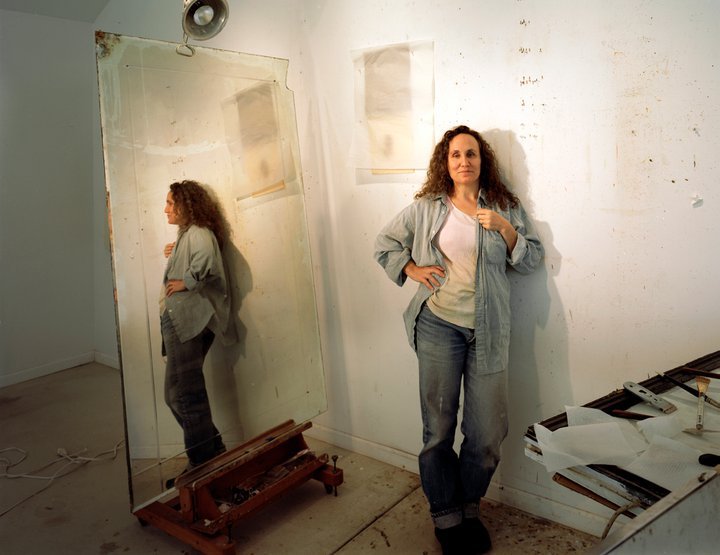
Artist Anne Harris has built her reputation as a painter of women who transfix their viewers with projections of uncomfortable and uncanny emotional states. Each of her paintings is a paradox, a challenge, a chimera, and to some degree a self-portrait.
"They start with me -- often -- and are from me in some respect," Harris explains, "but in the end, they become themselves. They're portraits of the people in the paintings." The resulting "people" are born from the artist's discomfort.
"I am incredibly self conscious," says Harris, "I am not a comfortable person." Although Harris, who recently turned 50, can be self-deprecating, her point has to be taken seriously. Her paintings are, in some way or another, about her struggle to get to the root of the anxiety while also attempting to shield herself from it. They tend to take their viewers on quite a ride.
Some of Harris' most memorable paintings of the 1990s were nude self-portraits that suggested a haunting vulnerability and ripeness. Pregnancy, always a nervous time, accounted for only part of the work's susceptibility. Harris, who is characteristically honest, used the process of painting itself to explore subtle ways that she could make what at first appeared vulnerable opaque.
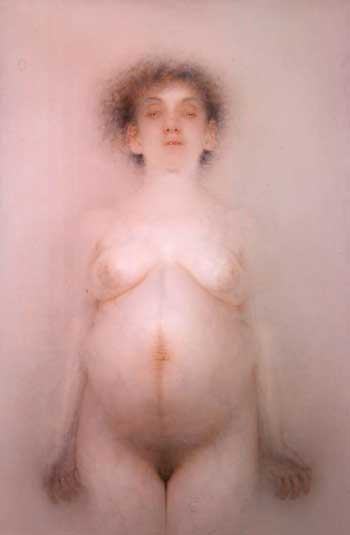
Oil on canvas, 46 1/8" x 30"
To put it another way, Harris is an expert in playing a game of paradoxically revealing and hiding: the result is the art. " If it really works it should go beyond my original intention and take on its own life, " says Harris about her process, "That's when I am done with it."
Harris insists that it is up to viewers to bring their own meanings to the work: "They are never wrong," she states. If her paintings are, in her own mind, " mesmerizing, hypnotic, emotionally complicated, and difficult" she has done her job.
In the past decade Harris has been hard at work developing chameleonic series of paintings of women who channel a panoramic range of emotional nuance. The most surprising thing about them -- as varied as they at first appear -- is that they are also self portraits. It took Harris by surprise when the author of a catalog essay for her 2003 Exhibition at Bowdoin College -- Without Likeness: Paintings by Anne Harris -- referred to some of her subjects as "invented adolescents."
"I was shocked," Harris recalls, "I hadn't thought that at all: they were all starting from myself."
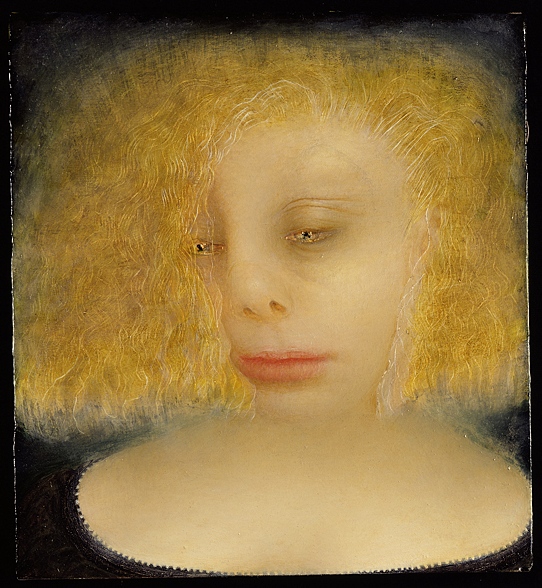
Oil on Linen, 12" x 12"
Harris recalls her childhood, during which her family constantly moved, as being all over the place. "It went sort of like this," Harris recounts, "... born in Cleveland, then 2 yrs in Syracuse, 2 yrs. near Phoenix, AZ (Williams Air Force Base), 2 more yrs in Syracuse, 6 years in Tucson, AZ, 4 years in Morehead, KY. Although I see that only adds up to 16 years; my parents made some short moves when I was a toddler that I don't remember."
She wound up attending college in St. Louis, at Washington University, and then earned her MFA Degree in Art at Yale, graduating in 1988. While teaching in Maine she met her husband, photographer Paul d'Amato, and gave birth to her son Max in 1995. Shows in New York, Boston and New Mexico helped firm up her reputation, and critics often grouped her with other artists testing new approaches to self-portraiture and "partial self-portraiture" including Julie Heffernan and Lisa Yuskavage.
Everything changed for Harris when she and her family moved to Chicago in early 2001. "I was pining for New England," she states, "Moving was hard." Painting came to a halt, and Harris found her momentum again through drawing, which she devoted herself to exclusively for more than a year and a half. In 2006 a bracing cross section of 86 "drawings," which included mixed-media experiments with watercolor, oil and graphite, were tacked to the wall of the Neilsen Gallery in Boston.
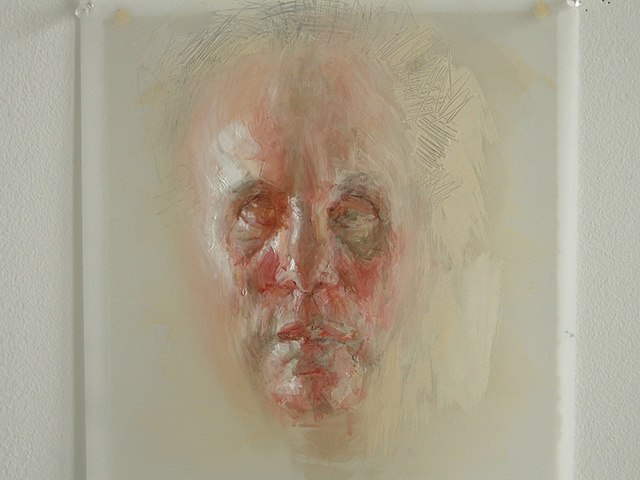
Water color, oil, graphite on mylar over paper, 12" x 10"
After executing several hundred drawings, Harris found herself productive at the easel again, and several important shows followed. In a group show titled "Beyond Likeness," held in 2007 at the North Dakota Museum of Art, and curated by Laurel Reuter, Harris showed a total of nearly 200 drawings and paintings. A solo show at Alexandre Gallery in New York -- also in 2007 -- consisted of mainly drawings along with two paintings.
In the past few years, Harris has referred to the subjects of many of her paintings as "invisibles." A few, like her "Portrait" of 2007 are "Middle-aged Angels."
"I have been looking in the mirror," Harris acknowledges, "In the mirror it is all myself." The resulting images, characteristically, are someone and something else. In many cases the painting is "...its own entity: I don't even know how it got there."
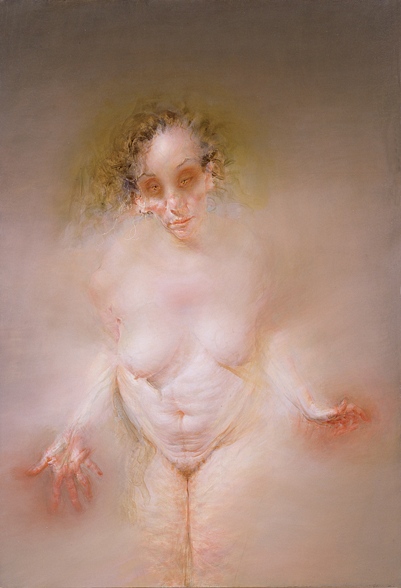
Oil on linen, 44" x 30"
Props -- a string of mardi-gras pearls, an antique dress, a bathrobe -- are devices that Harris uses to help a painting gain momentum. They can be important because they are more constant and tangible than the female figures themselves, who tend to morph during the painting process. In "Portrait (Pink) from 2010 the carefully rendered patterns of a pale sheath dress provide the counterpoint to an amber eyed "invisible" who seems to waver and waste into the painting's toned ground.
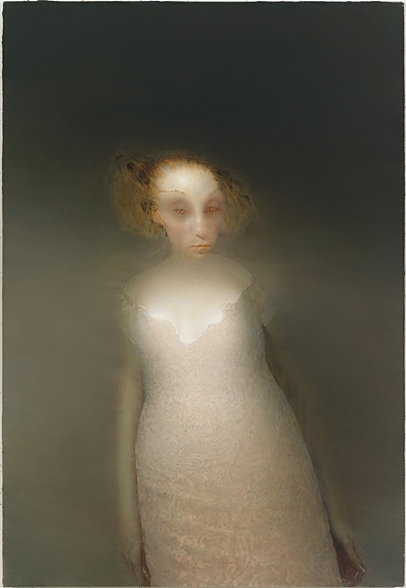
Oil on linen, 44" x 30"
Few painters today, male or female, are courageous enough to present themselves as Harris does in her work in progress "Red Robe." Frowsy, fright-wigged -- even possessed -- it shows us a Medusa who confronts, disorients and challenges us. If Harris is willing to claim the emotions and images suggested by this painting, she is a step closer to Goya than any other artist working today.
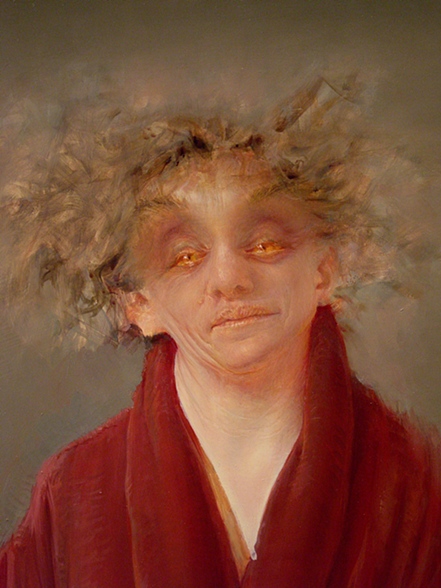
Oil on Linen
Then again, "Red Robe" isn't a painting that anyone should read as "meaning" anything: Harris herself is clear about that when it comes to reading her work. Her job as an artist was to give birth to the image, not to tell us what it means. Miles Unger, who wrote about Harris in 1997, put it this way:
"As our gaze is fixed by the helpless figure on the canvas, the artist slips out the back door, empowered, redeemed, through the very act of painting."
Anne Harris is represented by the Alexandre Gallery, New York.
